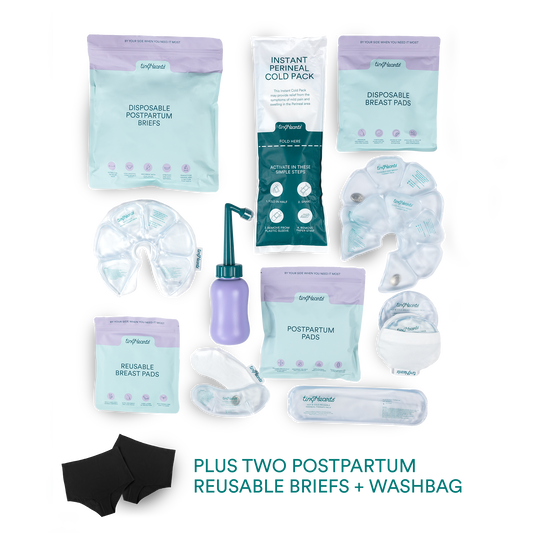The best way to introduce allergenic foods to your baby
As a parent, you will experience many exciting milestones with your little one. One of these milestones that seem to bring up both excitement and some anxiety in parents is introducing foods that commonly cause an allergic reaction. 1 in 10 babies has a food allergy. The good news is that you can reduce the chance of your baby developing an allergic reaction simply by introducing your baby to these foods before they turn 1. Learning and preparing your plan of attack if an allergic reaction happens will also help you remain calm and confident to support your child in these situations.

When do I start introducing the common allergenic foods?
Start introducing the common allergy-causing foods when you start introducing solids to your baby. The exact time to start will differ from baby to baby, so look for the signs that your baby is ready for solids. Some signs your baby is ready for solid foods include: Good head and neck control Able to sit upright Reaching for food Watching food Opens mouth when food is offered We have a blog post Introducing Solids that covers this in more detail.
What foods do I need to introduce? What are the most common allergenic foods?
The top 10 allergy-causing foods should be introduced to your child before they turn one. These are the most common food allergies:
- Cow's milk
- Egg
- Fish
- Shellfish
- Peanut
- Soy
- Sesame
- Tree nuts
- Wheat
- Lupin

What is the safest way to introduce common allergenic foods?
Get trained in baby and child First Aid
Get peace of mind and complete confidence when introducing solids and allergy-causing foods to your little one by doing a first aid course. The Tiny Hearts first aid course covers what to do if your baby is choking, what to do if your child has an anaphylactic reaction and what to do if your baby needs CPR. Anaphylaxis can happen quickly and if not treated, can be deadly.
Best timing for introducing food allergens:
Avoid introducing allergenic foods when your child is sick. Make sure your baby is well and has no symptoms of illness or signs of an eczema flare-up. Introduce in the morning or after a nap. This allows you to monitor your baby for any signs of an allergic reaction. Remember, allergic reactions can happen 2 hours after contact with the food. Introduce one allergenic food at a time. When giving your baby foods that are common food allergies, make sure to do so one at a time. This will make it easier for you to determine which food your baby is allergic to. Use an allergy tracker to keep track of what foods you have introduced and how many times that food has been given. Another handy tip: avoid the food touching the skin around the mouth. Use a barrier cream such as vaseline to protect the skin.

The first introduction to a food allergen
Start with a small amount. Somewhere between 1/8 - 1/4 of a teaspoon (just a small smear!) If there is no reaction to the food, mark down on your tracker that there was no reaction on the first exposure.
If your baby does not have any reaction to the food
Continue to give that food to your baby regularly (twice weekly) as part of a varied diet. Food allergies may develop if a baby is introduced to a particular food and the same food is not given regularly. The next time you introduce that food to your baby, double the amount you gave the first time.
How do I introduce eggs to my baby?
When introducing eggs, make sure that it is cooked thoroughly. Mash hard-boiled egg into vegetable or fruit puree, water, breastmilk, formula or yoghurt
How do I introduce cow's milk to my baby?
Do not give cows' milk as a drink to children under 1. Introduce cow's milk through plain yoghurt, smooth ricotta, or custard. Mix with fruit puree or other well-tolerated foods.
How do I introduce peanuts to my baby?
Keep in mind that peanuts are a common choking hazard to children because of their shape and size. Do not give whole nuts to your child before the age of 5. Introduce peanuts by giving your child smooth peanut butter mixed with water, breastmilk or formula to form a puree.
How do I introduce lupin to my baby?
Lupin is a legume found in many food products, such as bread, pasta or noodles. Introduce lupin to your baby by finding a bread that contains lupin (most gluten-free breads), soak it in breastmilk, formula or water and add it to cereal or puree.
What does an allergic reaction to food look like?


Allergic reactions can happen 2 hours after exposure to the trigger. Make sure you monitor your child for signs of an allergic reaction for at least 2 hours after giving the food. These are what some mild to moderate symptoms look like:
- Swelling of the lips, face, or eyes
- Hives or welts
- Tingling mouth
- Abdominal pain
- Vomiting
Allergic reactions don't usually happen the first time you introduce a new food to your baby. We recommend tracking at least three exposures to each of the top 10 allergy-causing foods. However, remember that an allergy can occur anytime, even after the three exposures.
What do I do if my baby has a mild allergic reaction?
If your baby has a mild reaction to the food you have given them:
Stop giving them the food.
If required, give them an age-appropriate antihistamine.
Monitor their signs, write down any reactions, and take photos or videos.
Seek medical advice before giving them the food again.
If the symptoms become more severe, you are concerned about their breathing, or you suspect an anaphylaxis reaction is occurring - call for an ambulance (000).
online baby & child first aid
$145
Learn baby & child first aid from your device at home! Purchase now and learn right away.
Our instant access course includes over 38 videos and 15 bonus downloads including content on whooping cough, croup and more!








